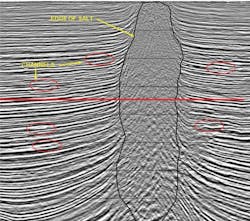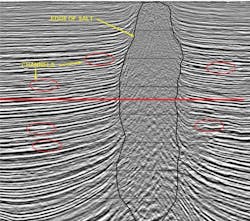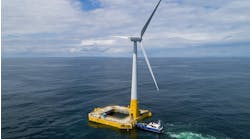Marco Aburto - Schlumberger
Piero D’Ambrosio - formerly with Schlumberger
Deepwater drilling today – in the Gulf of Mexico and other basins worldwide – often involves drilling both salt and subsalt intervals. Over the past decade, the use of expandable concentric underreamers or “hole openers” in deepwater drilling has become widespread. An estimated 75% of the salt/subsalt sections in the GoM now use underreamers. There are various reasons to enlarge a hole, including to enhance equivalent circulating density, to reduce cementing pressures, and to counter salt creep so casing will reach bottom. Underreamers are especially important in deepwater wells that require numerous casing strings.
However, incorporating underreamers in the bottomhole assembly (BHA) has altered drilling dynamics by introducing new sources of shock and vibration, which can cause a variety of system failures prior to reaching the next planned casing point. Under certain conditions, the underreamer can wear out faster than the drill bit. Non-productive time and expenses associated with making an extra trip out of hole to replace a damaged underreamer or another BHA component increase dramatically with the wellbore’s depth and length. For example, changing a dull underreamer at 25,000 ft (7,620 m) in the GoM typically takes about a day and a half of rig time, costing at least $1.5 million.
Therefore, proper BHA design – including underreamer selection, placement, and stabilization – is critical for operators to achieve optimal deepwater salt and subsalt drilling performance.
Underreamer/BHA performance analysis
Shortly after the introduction of expandable concentric underreamers for salt/subsalt drilling, Schlumberger created a tracking system to evaluate overall underreamer/BHA system performance in the GoM. Over the first few years, records indicated increasing shock and vibration incidents involving drilling tools such as rotary steerable systems, measurement-while-drilling (MWD) and logging-while-drilling (LWD) systems, and other BHA components.
To protect these tools from high levels of shock and vibration, and to ensure optimal BHA design while drilling with hole openers, existing data was analyzed and lessons learned documented throughout the Drilling Engineering Center to establish an initial set of best practices based on extensive experience with many operators and vendors. As a result, BHA incidents began to decrease.
Last year, the analysis was brought forward, evaluating seven years of data from more than 500 underreaming runs and more than 1 million ft (304,800 m) of hole enlarged in salt and subsalt intervals. Based on this analysis, two sets of recommendations are available for operators. The ultimate goal, of course, is to drill from casing point to casing point with a single BHA, avoiding any unplanned trips.
A general recommendation for any deepwater salt/subsalt drilling operation involving hole enlargement is to ensure that all parties – operator, drilling services company, bit, and underreamer vendors – actively collaborate to identify the safest, most appropriate BHA components for the task at hand. Lack of coordination often leads to unnecessary, and costly, underreamer or BHA problems. Everyone must understand each other’s concerns, and work together toward the optimal solution.
Drilling the salt section with hole openers
The first set of recommendations applies to optimizing the performance of drilling with hole openers through salt, which in a typical GoM deepwater well may constitute more than half the length of the wellbore. Optimizing performance in this section, therefore, can save substantial time and money. Today, the majority of runs through salt are drilled vertically, although there appears to be a trend toward more directional applications. The following best practices, widely proven in the field, aim primarily to mitigate underreamer-related shock and vibrations to the BHA, and to avoid component failures or BHA twist-off.
Drilling the subsalt section with hole openers
The second set of recommendations applies to optimizing directional drilling with hole openers below salt. The majority of subsalt runs today are directional. To avoid premature termination of a run, the following three best practices aim to ensure underreamer durability in the typically harder, more abrasive subsalt section. Unlike the previous recommendations, operators have not yet widely implemented these.
What’s the payoff?
As noted above, prior to implementing these best practices, increasing tool/BHA shock and vibration were recorded when introducing expandable concentric underreamers in deepwater salt/subsalt drilling. In 2004, for example, 24% of underreaming runs in the GoM had a negative impact on BHA performance due to suboptimal practices. Applying the recommendations outlined in this paper has reduced the incident rate to 8% by the end of 2007.
While many underreamer dynamics unknowns remain, successful BHA performance depends on the careful integration of bit and underreamer technology, and appropriate drilling practices. BHA success must be measured as a system. These recommendations have proven effective in the GoM.
Authors’ note
This article is based on paper AADE 2009NTCE-09-02: The Evolution of Hole Opening while Drilling Practices to Enlarge Salt and Subsalt Sections in the Gulf of Mexico, and was originally presented at the 2009 AADE American Association of Drilling Engineers in New Orleans, Louisiana, March 31, 2009.




